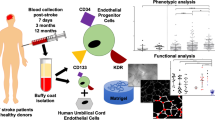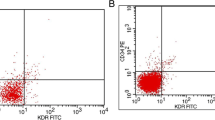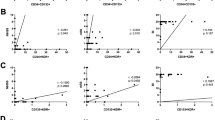Abstract
Endothelial progenitor cells (EPCs) have important effect in tissue repair in ischemic organs. The present study was conducted to demonstrate the mobilization of EPCs and its possible mechanism after acute ischemic stroke (AIS). A total of 148 individuals were examined, including 106 patients with ischemic stroke and 42 healthy controls. Seventy-one patients with imaging-confirmed AIS were examined at days 1, 7, 14, and 21 after stroke onset. Circulating EPCs were quantified by flow cytometry using CD133 and KDR surface markers. Serum stromal cell-derived factor-1 (SDF-1) concentrations were determined by enzyme-linked immunosorbent assay. Patients with AIS had significantly lower EPC level than that in the controls (0.022 ± 0.013 vs 0.051 ± 0.020; p < 0.01). This difference did not remain significant after adjusting for risk factors at multivariate analysis. Blood pressure, triglyceride, low-density lipoprotein (LDL), and fasting blood sugar were inversely correlated with EPC levels (p < 0.01). Systolic blood pressure and LDL remained independent predictors of baseline EPC levels. The number of circulating EPCs increased on day 7 after AIS, reached a peak on day 14, and decreased on day 21. The concentration of SDF-1 had similar changes. The increment of EPCs was correlated with the infarct volume (r = 0.708; p = 0.006) and SDF-1 concentration on day 14 (r = 0.714; p < 0.001). Baseline EPC level in patients with AIS reflects the cumulative vascular endothelial damage. EPCs could be mobilized into peripheral circulation in response to stroke stress. This mobilization was associated with the increased expression of SDF-1.




Similar content being viewed by others
References
Asahara T, Murohara T, Sullivan A (1997) Isolation of putative endothelial progenitor cells for angiogenesis. Science 275:964–967
Kaneko Y, Tajiri N, Shinozuka K, Glover LE, Weinbren NL, Cortes L et al (2012) Cell therapy for stroke: emphasis on optimizing safety and efficacy profile of endothelial progenitor cells. Curr Pharm Des 18:3731–3734
Griese DP, Ehsan A, Melo LG, Kong D, Zhang L, Mann MJ et al (2003) Isolation and transplantation of autologous circulating endothelial cells into denuded vessels and prosthetic grafts: Implications for cell-based vascular therapy. Circulation 108:2710–2715
Hill JM, Zalos G, Halcox JP, Schenke WH, Waclawiw MA, Quyyumi AA et al (2003) Circulating endothelial progenitor cells, vascular function, and cardiovascular risk. N Engl J Med 348:593–600
Yip HK, Chang LT, Chang WN, CH L, Liou CW, Lan MY et al (2008) Level and value of circulating endothelial progenitor cells in patients after acute ischemic stroke. Stroke 39:69–74
Werner N, Kosiol S, Schiegl T, Ahlers P, Walenta K, Link A et al (2005) Circulating endothelial progenitor cells and cardiovascular outcomes. N Engl J Med 353:999–1007
Schmidt-Lucke C, Rossig L, Fichtlscherer S, Vasa M, Britten M (2005) Kamper Uet, et al. Reduced number of circulating endothelial progenitor cells predicts future cardiovascular events: proof of concept for the clinical importance of endogenous vascular repair. Circulation 111:2981–2987
Navarro-Sobrino M, Rosell A, Hernandez-Guillamon M, Penalba A, Ribó M, Alvarez-Sabín J et al (2010) Mobilization, endothelial differentiation and functional capacity of endothelial progenitor cells after ischemic stroke. Microvasc Res 80:317–323
De Falco E, Porcelli D, Torella AR, Straino S, Iachininoto MG, Orlandi A et al (2004) SDF-1 involvement in endothelial phenotype and ischemia-induced recruitment of bone marrow progenitor cell. Blood 104:3472–3482
Ratajczak MZ, Reca R, Wysoczynski M (2006) Modulation of the SDF-1-CXCR4 axis by the third complement component (C3)-implications for trafficking of CXCR4+ stem cells. Exp Hematol 34:986–995
The fourth national conference of cerebrovascular disease (1996) Diagnosis points of cerebrovascular disease and Clinical neural function deficit score criteria. Chinese Journal of Neurology 29:379–383
Adams HP Jr, Bendixen BH, Kappelle LJ, Biller J, Love BB, Gordon DL et al (1993) Classification of subtype of acute ischemic stroke. Definitions for use in a multicenter clinical trial. TOAST. Trial of Org 10172 in Acute Stroke Treatment. Stroke 24:35–41
Khan SS, Solomon MA, McCoy JP Jr (2005) Detection of circulating endothelial cells and endothelial progenitor cells by flow cytometry. Cytometry B Clin Cytom 64:1–8
Ghani U, Shuaib A, Salam A, Nasir A, Shuaib U, Jeerakathil T et al (2005) Endothelial progenitor cells during cerebrovascular disease. Stroke 6:151–153
Meamar R, Nikyar H, Dehghani L, Talebi M, Dehghani M, Ghasemi M et al (2016) The role of endothelial progenitor cells in transient ischemic attack patients for future cerebrovascular events. J Res Med Sci 21:47
Zhou WJ, Zhu DL, Yang GY, Zhang Y, Wang HY, Ji KD et al (2009) Circulating endothelial progenitor cells in Chinese patients with acute stroke. Hypertension Research 32:306–310
Vasa M, Fichtlscherer S, Aicher A, Adler K, Urbich C, Martin H et al (2001) Number and migratory activity of circulating endothelial progenitor cells inversely correlate with risk factors for coronary artery disease. Circ Res 89:E1–E7
Roberts N, Jahangiri M, Xu Q (2005) Progenitor cells in vascular disease. J Cell Mol Med 9:583–591
Liang C, Feng H, Deng BQ, Li ZF, Huang QH, Zhao W et al (2014) Decreased levels and function of circulating endothelial progenitor cells in unruptured intracranial saccular aneurysm patients. Neurol Sci 35:23–28
Shichinohe H, Kuroda S, Yano S, Hida K, Iwasaki Y (2007) Role of SDF-1/CXCR4 system in survival and migration of bone marrow stromal cells after transplantation into mice cerebral infarct. Brain Res 1183:138–147
Bogoslovsky T, Bogoslovsky A, Chaudhry L, Maric D, Luby M, Spatz M et al (2010) Endothelial progenitor cells correlate with lesion volume and growth in acute stroke. Neurology 75:2059–2062
Ding DC, Shyu WC, Lin SZ, Li H (2007) The role of endothelial progenitor cells in ischemic cerebral and heart diseases. Review. Cell Transplant 16:273–284
Borlongan CV, Glover LE, Tajiri N, Kaneko Y, Freeman TB (2011) The great migration of bone marrow-derived stem cells toward the ischemic brain: therapeutic implications for stroke and other neurological disorders. Prog Neurobiol 95:213–228
Duan XX, Zhang GP, Wang XB, Yu H, Wu JL, Liu KZ et al (2015) The diagnostic and prognostic value of serum CXCL12 levels in patients with ischemic stroke. Neurol Sci 36:2227–2234
Fan Y, Shen F, Frenzel T, Zhu W, Ye J, Liu J et al (2010) Endothelial progenitor cell transplantation improves long-term stroke outcome in mice. Ann Neurol 67:488–497
Funding
This work was supported by the National Natural Science Foundation of China (31100985).
Author information
Authors and Affiliations
Corresponding author
Ethics declarations
This study was approved by the ethics committee in Chongqing Medical University, and all procedures involving human participants were in accordance with the ethical standards of the institutional and/or national research committee and with the 1964 Helsinki Declaration and its later amendments or comparable ethical standards. Informed consent was obtained from all individual participants.
Conflict of interest
The authors declare that they have no conflict of interest.
Rights and permissions
About this article
Cite this article
Deng, Y., Wang, J., He, G. et al. Mobilization of endothelial progenitor cell in patients with acute ischemic stroke. Neurol Sci 39, 437–443 (2018). https://doi.org/10.1007/s10072-017-3143-y
Received:
Accepted:
Published:
Issue Date:
DOI: https://doi.org/10.1007/s10072-017-3143-y




